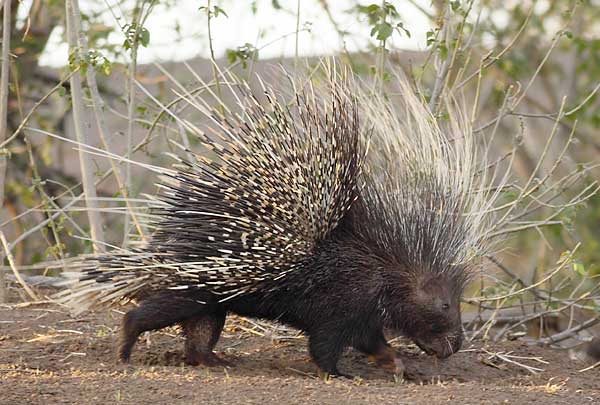
Last week, I danced out of the house to do my morning chores, energized by the cool weather. Then I saw white stuff on my Karakachan’s face. Foam? Chicken feathers? I bent down and the dog’s eyes said, “I made a mistake.” When I opened his mouth I saw dozens of porcupine quills in his tongue, his throat, his gums and lips. The dark, sharp quills were hard to pull out and seemed to break off, leaving the white feathery part in my hand. My Great 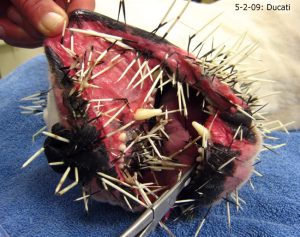 Pyrenees, who acts like a big baby half the time, would not let me touch him; his feet and the outside of his mouth were covered with quills. He growled at me when I approached him with the leash. Unheard of! On the left is one of the dozens of photos of quills in dogs’ mouths on the internet, and this one is by no means the worst. I didn’t think to take a photo of my dogs since I was hurriedly loading them up for a trip to the vet. I had to lure the Pyr into the truck with hamburger. They were anesthetized and given pain medication and antibiotics and are now fine. Two dog owners appeared just after me with dogs bristling with quills; the vet said a couple of days later that they had been swamped with dogs who had been in battle with porcupines.
Pyrenees, who acts like a big baby half the time, would not let me touch him; his feet and the outside of his mouth were covered with quills. He growled at me when I approached him with the leash. Unheard of! On the left is one of the dozens of photos of quills in dogs’ mouths on the internet, and this one is by no means the worst. I didn’t think to take a photo of my dogs since I was hurriedly loading them up for a trip to the vet. I had to lure the Pyr into the truck with hamburger. They were anesthetized and given pain medication and antibiotics and are now fine. Two dog owners appeared just after me with dogs bristling with quills; the vet said a couple of days later that they had been swamped with dogs who had been in battle with porcupines.
I, by no means object to all wars; sensible, necessary war is – well, necessary. But the conflicts between dogs and porcupines is a perfect example of the pointless, wasteful wars that I have opposed all of my adult life. Porcupines are small creatures and 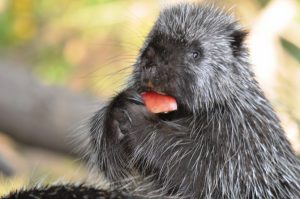 herbivores; none would dream of eating a chicken or lamb or small calf. There is no competition between them and predators. The savvy coyote is said to ignore them; big cats like leopards attack them. So do dogs. The porcupine signs its death sentence when it provokes a predator; it raises its quills and furiously waves its spiky tail from side to side and up and down, beating the ground. Its aggression sadly inflames the aggression of a large, strong animal with big teeth.
herbivores; none would dream of eating a chicken or lamb or small calf. There is no competition between them and predators. The savvy coyote is said to ignore them; big cats like leopards attack them. So do dogs. The porcupine signs its death sentence when it provokes a predator; it raises its quills and furiously waves its spiky tail from side to side and up and down, beating the ground. Its aggression sadly inflames the aggression of a large, strong animal with big teeth.
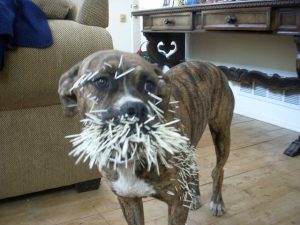 Underneath their friendly ways, dogs are proud creatures, territorial at heart and many, like my guardian dogs, are bred to protect–to do their duty. Some are protective of their humans; mine protect chickens and livestock. My dogs embrace their guard duties. But in a tangle with a 20-pound porcupine, a predator’s injuries are often fatal. The quills are constructed to burrow deeper into flesh as time goes by.
Underneath their friendly ways, dogs are proud creatures, territorial at heart and many, like my guardian dogs, are bred to protect–to do their duty. Some are protective of their humans; mine protect chickens and livestock. My dogs embrace their guard duties. But in a tangle with a 20-pound porcupine, a predator’s injuries are often fatal. The quills are constructed to burrow deeper into flesh as time goes by.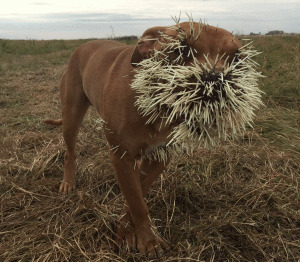 Untreated, infection sets in, then certain death. Neither the fearsome pit bull or the beautiful sports dog pictured here can survive the quills without help.
Untreated, infection sets in, then certain death. Neither the fearsome pit bull or the beautiful sports dog pictured here can survive the quills without help.
“Mistakes will happen.”
After much thought I decided to leave the little deceased porcupine on my property as a warning to other porcupines. I put it about 75 feet outside the invisible fence but should have gone further– I was not wearing boots and had seen a coral snake earlier in the week.
The black vultures arrived two days later. Not turkey vultures, but the huge two-foot birds with six-foot wingspans. The Pyr was not pleased and ran up and down his side of the invisible fence barking furiously. The birds were not certain the dog wouldn’t break through whatever restrained him, so instead of their usual leisurely meal they would dive down, sometimes sit on the fence briefly and then fly away. Fast food.
I have a breeding pair of Dexters; the cow and bull walked over companionably and looked through their side of the fence, staring for a long while at the porcupine; then watching the dog and the birds. They made me think of a couple on a date to the movies. The vultures finished their work and left. The late philosopher and farmer Gene Logsdon believes we should give thanks for the vultures since the world would be a smelly mess without them.
The Pyr probably just gave thanks when they were gone and he flung himself down on the grass to sleep–his work done. The cow and bull sought out their favorite shade tree.
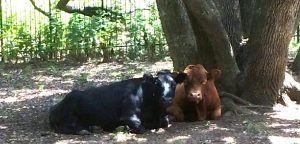
At peace. Peace. So very hard to know when it is worth it. So precious.